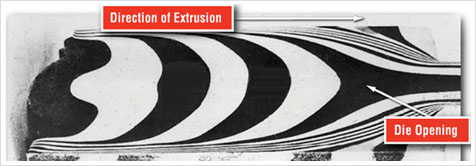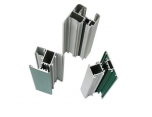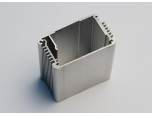Aluminum is a green material of choice. Aluminum’s inherent “green features” of recyclability and sustainability, coupled with its other unique attributes, make aluminum a versatile material for many applications, but the exciting story of aluminum doesn’t stop here. The ability to extrude aluminum into complex shapes (profile) gives designer creative freedom. Where the environment, time, cost and process repeatability are the important parameters, aluminum extrusions offer a material and process choice that is literally second to none for countless product applications.
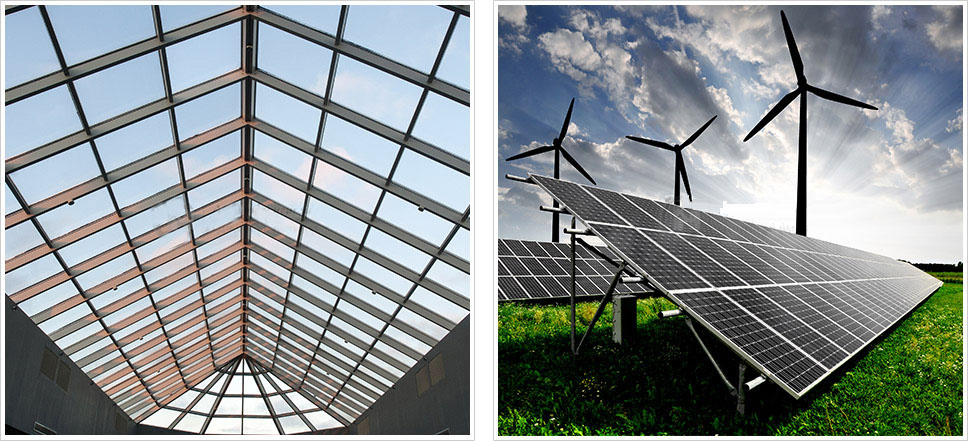
1、Advantages of Aluminum Extrusions
Aluminum extrusions (or profiles) have continuously demonstrated to be as superior in performance, reliability, and efficiency for a variety markets – from consumer durables to transportation and from electronics to building and construction. Where time, cost and process repeatability are important parameters to the designer, aluminum profile offer advantages unmatched by other material and processes.
Today’s designers are able to work with an abundance of materials including aluminum, steel, copper, plastic resins and composites, and with abundance of processes including roll, forming, stampings, castings, powder metal, injection molding, and plastic resin extrusion. Each material and process offers distinctive performance criteria for the designer. For many applications, aluminum – and specially the aluminum extrusion process – offers performance criteria exceeding those of alternative material and processes.
Aluminum profile offers a long list of advantages: first those inherent in aluminum, and second, those gained from the extrusion process.
| Aluminum’s Material Advantages |
 |
Aluminum Extrusion’s Process Advantages |
| Recyclable | Attractive | |
| Lightweight | Wide range of finishes | |
| Strong | Virtually Seamless | |
| High Strength-to-Weight Ratio | Complex Integral Shapes | |
| Resilient | Facilitate Fastening and Assembly | |
| Corrosion-Resistant | Readily Joinable | |
| Thermally Conductive | Reduce Steps in Fabrication | |
| Non-Toxic | Tight Tolerance | |
| Reflective | Cost-Effective | |
| Electrically Conductive | Short Lead Times | |
| Nonmagnetic | ||
| Nonsparking | ||
| Noncombustible | ||
| Cryogenically Strong | ||
2、Application of Aluminum Extrusions
Designers and Engineers constantly redefine innovation by creating lighter, stronger, environmentally sound products using extruded aluminum components.
| Featured Applications | ||
| Sunshades & Light Shelves | Atriums | Photovoltaic Panel Framing and Skylights |
| Stadium | Pedestrian Bridge | International Space Station |
| Solar Energy | Water & Wind Turbine | Electric Sports Car Chassis |
| Aluminum Space Frame for Premium Car | Aluminum Impeller | Mass Transit Bus |
| Floating Breakwaters | Trailer/Camper | Police single-rider transporter |
| Bicycle Wheel Rims | Volleyball Uprights | Digital Information Display Panel |
| New Wave Truss | Trade Show Booth Structure | Heat Sink |
| Sign Cabinet | ||

3、The Aluminum Extrusion Process
The aluminum extrusion process involves the use of a hydraulic press to force heated (still solid, but malleable) aluminum alloy through a steel die. The resulting aluminum profile assumes the shape (in cross section) of the die opening. The Process also involves the use of other equipment before and after the material runs through the press.
The starting material for extrusion, known as billet, is cut to the desired length and heated in a furnace prior to extrusion. After leaving the press, the aluminum profile is quenched (cooled), then subject to a variety of additional handling systems. The extrusion process follows a few simple steps, but can yield a multitude of shapes and forms.
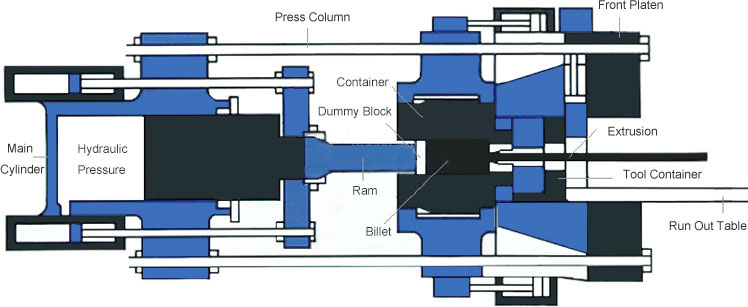
Raw aluminum in ingot form is melted and mixed with various combinations of metallic elements (and, sometimes, silicon) to form aluminum alloys. Each alloy has specific characteristics matching application needs. The alloyed material in ingot form, is then carefully cast into logs. These logs are later cut, to extruder specification, into a form known as billet.
|
Prior to entering the press container, the aluminum billet is |
Heated aluminum flowing through the container and out the die is represented here,with the direction of extrusion from left to right. Note that the center of the billet advanced more rapidly than the periphery, causing the surface segregation oxide to cling to the container wall, collecting in back-end residue. (The dark lines are copper bands, placed as markers to illustrate the flow of metal. |
Heating the aluminum for the extrusion process is accomplished either with electrically through induction heaters or through the use of gas-fired furnace. Once the aluminum has reached a specified temperature, generally ranging from 750 to 900 degrees Fahrenheit (approximately 400 to 480 degree centigrade), it is loaded into the container of the extrusion press.
Hydraulic force is applied by a ram, pushing the billet up against the die, and bringing it into full contact with the container wall. Once full contact is established, the pressure increases and the heated metal is pushed through the die opening to emerge on the other side as a fully shaped profile.
Extrusion presses operate in circles, with a cycle defined as on thrust of the hydraulic ram. The length of time it takes a press to go through one cycle is related to alloy, billet size, number of holes in the die, and the shape of the extrusion.
Depending on the alloy, a complex shape may emerge from the press as slowly as one or two feet per minute; while a simple shape may be extrude at a rate of more than 200 feet per minute. If we take various factors into consideration, a continuous extrusion as long as 300 feet may be produced with each stroke of the press. Pullers are commonly used to facilitate handling the hot and fragile profiles as they emerge from the die.
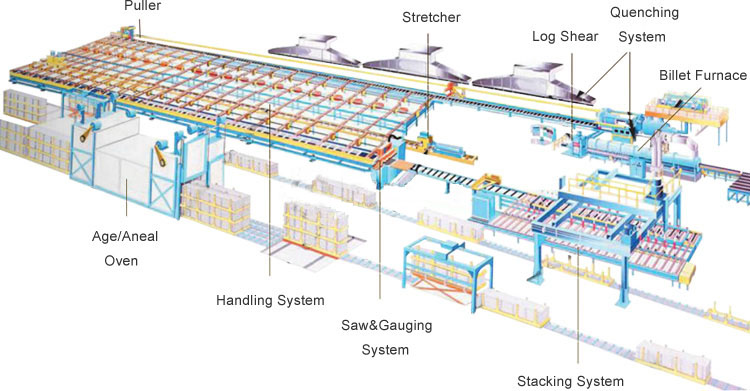
Although the extrusion press is the main focus of the extrusion processes, many other pieces of equipment are required to make an aluminum extrusion. In addition to the press, the illustration depicts a billet furnace, quenching system, log shear, puller, age/anneal ovens, handling equipment, saw and gauging system, stretcher, and stacking system.
4、Exit and Quench Temperature Data for Selected 6xxx-Series Alloys
|
Exit and Quench Temperature Data for Selected 6xxx-Series Alloys |
|||||
| Alloy | Min.PressExit Temp (Deg-F) | Critical Cooling Rate (Deg-F/sec) | Critical Cooling Range (Deg-F) | Cooling Time (sec) at Minimum Cooling Rate | Cooling Time (sec) at Maximum Cooling Rate |
| 6003 | 930 | 2-3 | 840-480 | 180 (at 2 deg/sec) | 120 (at 3 deg/sec) |
| 6463 | 930 | 5 | 840-480 | 72 (at 5 deg/sec) | 72 (at 5 deg/sec) |
| 6063A | 930 | 3-5 | 840-480 | 120 (at 3 deg/sec) | 72 (at 5 deg/sec) |
| 6060 | 930 | 3-5 | 840-480 | 120 (at 3 deg/sec) | 72 (at 5 deg/sec) |
| 6101 | 930 | 3-5 | 840-480 | 120 (at 3 deg/sec) | 72 (at 5 deg/sec) |
| 6005A | 950 | 5-15 | 860-480 | 76 (at 5 deg/sec) | 25 (at 15 deg/sec) |
| 6061 | 950 | 10-20 | 860-480 | 38 (at 10 deg/sec) | 19 (at 20 deg/sec) |
| 6082 | 950 | 10-20 | 860-480 | 38 (at 10 deg/sec) | 19 (at 20 deg/sec) |
| 6351 | 950 | 10-20 | 860-480 | 38 (at 10 deg/sec) | 19 (at 20 deg/sec) |
Note: Press exit temperatures refer to the temperature of the extrusion at the platen. These are a guide. Actual die exit temperatures are significantly higher.


